Events and excursions, Spring 2015
Spring Meeting and AGM, 2015
Report by Barbara Cast
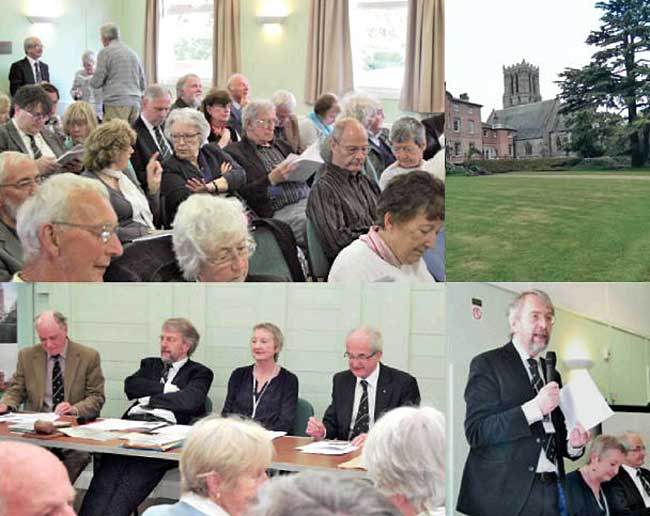
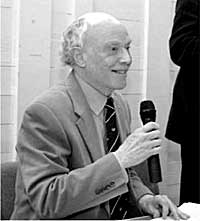 Our President, Adrian Henstock
Our President, Adrian Henstock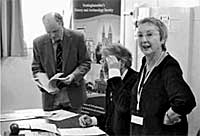
Adrian Henstock, John Beckett, Barbara Cast
On another fine spring day we met at Thurgarton for our Spring Meeting and AGM. 85 members were welcomed by our President, Adrian Henstock, who reminded them of how important the road through Thurgarton had been in the past, with the Augustinian Priory of St Peter at Thurgarton itself, Gonaston Spital at Broadbusk dedicated to St Mary Magdalene and Southwell Minster all ensuring that there was a great deal of ecclesiastical traffic. Added to the regular passage towards Southwell, said Adrian, was the annual Gate to Southwell when, from the Middle Ages to the mid 1600s, the Mayor and Corporation of Nottingham delivered, in all but the most extreme of weathers, the Southwell Pence to the Minster Chapter, sang a Te Deum and then turned round and went back to Nottingham - surely stopping at a few hostelries on the way! This custom was revived in various guises over the years, in recent times as a pilgrimage of Morris teams still under the name "The Gate to Southwell", with 2014 seemingly being the last such procession due, it seems, to 'health and safety' issues! The President also drew attention to the encouraging signs of a greater appreciation of the East Midlands' history, as was well demonstrated on the line of the Fosse Way, which could be called the Heritage Way linking as it does Leicester and its new Richard III Centre, the recently opened National Civil War Centre in Newark and Lincoln's new Magna Carta visitor centre at the castle there.
He reminded us that Nottingham Castle, one of the most important castles in England in the Middle Ages, was also in line for improvements.
Professor Beckett then presented the annual report and following this John Wilson, Honorary Treasurer, talked through the accounts which showed that the Society was using its financial resources wisely and to good effect. The Chair thanked John Wilson and also Peter Bloomfield who was our Independent Examiner.
In his Chair's remarks Professor Beckett noted that George Ridding, the first Bishop of Southwell, apparently thought that Thurgarton was a major city because he told his first Diocesan Conference that a bishop should live among his people, and then spent twenty years living in Thurgarton. His excuse was, of course, as John said, that it was on the main railway line from Newark to Nottingham, which in the 1880s was crucial for getting around. As he had once suggested that he should live in Ilkeston, Professor Beckett felt that this would not have been welcomed by his aristocratic wife! The Chair added just one important fact about Thurgarton which was relevant to the current commemorations of the First World War - it is one of the few villages in the county to have a war memorial which is not in the churchyard, probably largely because (again unusually) it was privately sponsored.
We missed David Bagley, our Circulations Secretary, who was not at the Transaction 'collection point' due to having recently undergone surgery. We heard that Council had agreed that, in view of her long service to the Society, our former President Rosalys Coope should be made an honorary member. She was also congratulated, together with Pete Smith, on their book in the Record Series about Newstead Abbey which was selling extremely well and had been nominated for an award by the Society of Architectural Historians.
Two officers stood down this year. Howard Fisher has resigned from the position of Newsletter Editor after six years, having very successfully developed the newsletter: we are very pleased that John Wilson and his new wife, Janet, have taken on the newsletter as a joint venture. The other retiring officer is Keith Challis who, after eleven years as our Archaeology Editor, has decided to stand down.
Keith was thanked for keeping the archaeology contributions coming in and to a high standard. We know from Council member, David Knight, that there have been a great many new finds recently as a result of ongoing work in the county - not least for the tram extensions in Nottingham - which should lead to some very interesting contributions to Transactions in the future which Dr Chris King of the Archaeology Department at Nottingham University will now be overseeing as the new editor.
Two members of Council also stepped down. Peter Reddish has been on Council for a number of years and is possibly best known to members for running round the hall in the Mechanics with the microphone during questions following lectures. Although he is leaving Council, Peter has agreed to keep running, and we thank him for that! Andy Nicholson is also standing down - he is our Webmaster, the editor of the Nottinghamshire Bibliography, controller of the Nottinghamshire Heritage Gateway, the technology behind the e-bulletin (now two years old), and many other technologically challenging roles, all of which he has agreed to continue doing. We were pleased to welcome Rob James on to Council. Rob is a relatively new member of the Society and was at our annual meeting last year. And he came back for more!
Professor Beckett took the opportunity to ask members to be as much involved with the activities of the Society as they could - remembering to publicise it at any events they might be involved in, keeping their eyes open for potential damage to the historic environment through planning or others developments, joining the team at history fairs etc.

Ellis Morgan gives his talk
After the business had concluded, Ellis Morgan, a local historian and Thurgarton resident, gave an excellent illustrated talk on the history and architecture of the Priory Church of St Peter. He paid tribute to two of the previous researchers on the Augustinian Priory, Jenny Alexander from whom he had learned much, and Trevor Foulds whose book "The Thurgarton Cartulary" was his 'bible' which he used regularly. He held it up to illustrate that it was very well-thumbed!
We then had tea, amply provided by Catherine's Bakery of Calverton. My thanks to the tea makers, pourers and washing uppers!
After tea many of us visited the remains of the priory which are now the parish church. Members were able to see the great pillars which indicated its previous size, rivalling that of the Minster just a few miles away. We also noted the wall painting of Walter Hilton, mystic of the priory, which was painted after the 1996 celebrations of Walter's life which some of you may remember. Thanks to the owner of Thurgarton Priory, the Georgian mansion which replaced much of the original priory, we were able to visit its undercroft and view the imposing arches and pillars and the hints of its previous uses.
It was another interesting and enjoyable spring meeting - we look forward to another next year - again in a different venue with a new place to explore.
THE MAURICE BARLEY LECTURE, SATURDAY 14th FEBRUARY 2015
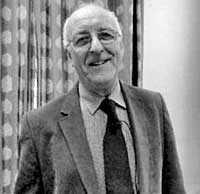
Dr Paul Everson delivers his lecture
Photograph © David Hoskins
Paul Everson and David Stocker - The corpus of Anglo-Saxon Stone Sculpture from Nottinghamshire: the County's Distinctive Antiquarian Tradition
Report by David Knight
Society members were treated to a fascinating presentation by Paul Everson, Honorary Lecturer at Keele University, on the subject of Nottinghamshire's rich heritage of Anglo-Saxon stone sculpture. The lecture was prepared jointly with David Stocker, Honorary Visiting Professor at Leeds University, but much to our regret David was prevented from attending by an unexpected hospital operation from which he was still recuperating.
Following completion of their study of Lincolnshire stone sculpture, published in 1999 as Volume 5 of the British Academy's Corpus of Anglo-Saxon Stone Sculpture of England, David and Paul embarked upon a detailed investigation of Nottinghamshire's Anglo-Saxon stone sculpture. This has now been completed, with input also from Dr Graham Lott on geological sources and Dr David Parsons on epigraphy, and will be published by Oxford University Press later this year as Volume 12 of the British Academy series.
Pre-Conquest sculpture was one of the many subjects that had intrigued Maurice Barley and hence provided a particularly appropriate subject for this annual commemorative lecture. Paul discussed Maurice's contribution to this subject towards the end of the lecture, which focused upon the history of antiquarian investigation from the first descriptions of Anglo-Saxon stonework in Throsby's expanded edition of Thoroton's pioneering study of the antiquities of Nottinghamshire. We were led expertly through the maze of antiquarian studies, encountering en route the work of key figures such as William Stretton, Edward Trollope, William Stevenson and his son William H. Stevenson, Cornelius Brown, Arthur du Boulay Hill, Alfred Stapleton, J. Romilly Allen, Bishop Browne and of course Maurice Barley. Their investigations illuminated a wide range of material, including decorated stone crosses, grave covers and fragments of figurative scenes, and in some cases provide the only record of material that has subsequently been lost. Paul discussed the circumstances of discovery, iconography and significance of the sculptured stonework, drawing particular attention to the incorporation of material in later church buildings, notably at Hawksworth, Church Warsop and East Bridgford, and the riverine focus of many stone crosses.
At Stapleford, Shelford, Rolleston and South Muskham, for example, crosses may have marked both river crossings and boundaries, while their Trent Valley location supports the growing evidence that the Trent had marked a significant cultural boundary and transport route during the Anglo-Saxon period.
THE MYLES THOROTON HILDYARD LECTURE, SATURDAY 14 MARCH 2015
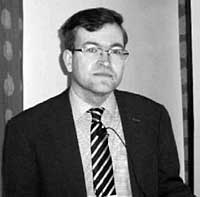
Dr Richard Gaunt
Photograph © David Hoskins
Dr Richard Gaunt, Associate Professor, University of Nottingham
Nottinghamshire and the Great Peace: Reflections on the End of the Napoleonic Wars, 1815
Report by Professor John Beckett
One hundred years ago the people of Nottinghamshire were engaged with their fellow countrymen in the First World War.
There was little time to commemorate the defeat of Napoleon at Waterloo in May 1815, but one hundred years further on in 2015 - and in peace time - there is greater scope for examining the end of what had been more than twenty-years of almost continuous warfare with the French. The response to Waterloo in Nottinghamshire was curious. Local people celebrated with gusto the Treaty of Paris of 1814, following which Napoleon was despatched into exile on the isle of Elba. His subsequent daring escape and the final, decisive confrontation with the Duke of Wellington at Waterloo on 18 June 1815, almost passed the county by, and there were no public celebrations.
Richard Gaunt's knowledge of the period, and of the events of 1814-15 made for an excellent lecture which included numerous references to relevant events in the county. The illustrations were also memorable, none more so than the buried leg! In the closing moments of the battle a cannon ball struck the Earl of Uxbridge as he rode with the Duke of Wellington. The Duke said 'By God, Sir, you've lost your leg,' to which the Earl replied 'By God, Sir, so I have'. The remains of the leg were amputated in a house nearby and the owner buried the leg in his garden: Richard's research had taken him to the garden where he had taken a picture of the site of the buried leg!
Richard offered the lecture as a foretaste of a major new exhibition he is curating at the Weston Gallery, Lakeside, between 22 May and 6 September. For more details of the exhibition, please see: http://www.lakesidearts.orq.uk/Exhibitions/ViewEvent.html?e=2860&c=5&d=3257.